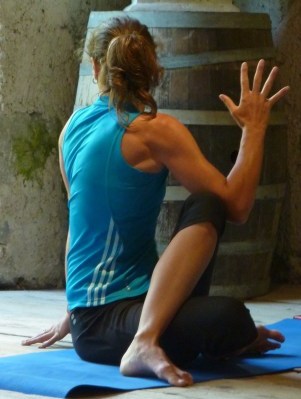Jun 15, 2015
Asana – Keeping the practice integral

What constitutes an integral practice?
What’s the difference between gymnastics and asana? Gymnastics and circus antics offer a chance to develop strength, stamina, flexibility, balance, grace, and poise in the human form, so too does yoga. Gymnastics and circus depend on one’s ability to focus and to concentrate in order to move dextrously and skilfully, so too does yoga. Then what is it that marks the turning point from merely physical training to a spiritual practice? In gymnastics and circus sequences of movements are combined together to create perfection in form. They are performances whereby the rewards are in the accomplishment of the moment. Handstand into splits: done! A tumble ending in a double summersault: done! Through relentless practice, the aim is to forge the body into predetermined movements, postures; form.
Yoga asana on the other hand is beyond form. Its integrity lies in one’s approach and attitude to the practice, in how one performs the practice and the results that the practice brings. Integral practice is that which brings a calming and soothing effect on the central nervous system and initiates the parasympathetic nervous system to work its wonders of healing and regeneration. Integral practice is that which placates the ego and founds an undeniable, tangible, and real experience of unification and connection on many levels of our being and our existence. Integral practice is that which massages the physical, emotional, and mental bodies free from tensions and trauma. Integral practice is that which creates fertile ground for positive and beneficial personal transformation and growth.
For seasoned practitioners, the integral practice of asana offers a beautiful arena of self-discovery and exploration. It can be said to arise under certain conditions that we as practitioners aim to facilitate when we enter into something that is more than just posture making. What are those conditions? Unquestionably it is sensitivity and awareness.
For many of us, the trademark of an integral practice is an ever-deepening degree of sensitivity and awareness that gradually allows us to feel and experience many things about ourselves that we are most often oblivious to. An awareness that creates space inside of us and elicits new personal freedoms of different kinds; physical, emotional, and mental. It is our ability to be present and approach practice as mediation that extends an invitation to sensitivity and awareness to blossom into our practice. This presence of mind creates a crucible in which the subtle workings of yoga take place. It contains our energies, reorganizing our thoughts and feelings into more harmonious and balanced configurations.
Still not sure of what I am talking about or how to change the way you in which you practice so that the fruits of integral practices become within your reach?
Fine-tuning our awareness and awakening our sensitivity is a process that requires repetition in practice. Initially having the right guidance to support you to internalize can speed up the evolution of your practice. That guidance can simply come from within if you can listen closely enough and respond to the innate wisdom that is always softly speaking from the inner realms of our Being, but for many of us, it helps to have some form of training under the guidance of experienced teachers who have already reached a level of integrity in their practice. That’s the beauty of a one-month yoga teacher training intensive courses. As well as asana and other yogic practices yoga teacher training also offer the arena to study the all-important theory. The theory makes asana less of a mystery and more of a practical tool to self-exploration.
Comments are closed here.